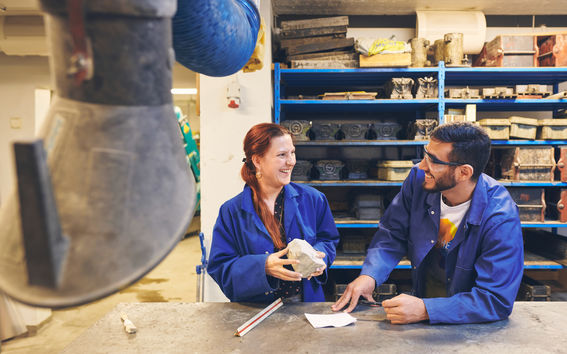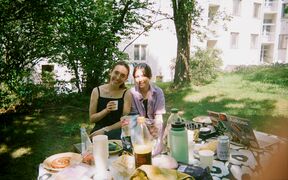Sara Troberg
A master's degree in the field of construction took Sara Troberg from Otaniemi to New York.

TheMaster's Programme in Civil Engineering deals with the design, construction, use, and maintenance of civil engineering structures, such as buildings and bridges. Since civil engineering plays a central role in creating safe and sustainable living spaces, working in the field gives you a real chance to help the society in solving environmental issues and shape the future for the better. Knowing how to build durable structures, utilise sustainable materials, improve energy efficiency, and reuse structures and materials to advance the circular economy – these are some of the essential competences today’s experts need.
This programme educates future professionals and leaders who seamlessly merge science as well as environmentally responsible and human-centric design to help the transition towards a smarter built environment. As a young university, Aalto offers students a more modern and refreshing approach to study civil engineering. The teaching in this programme is highly research-based – students get insights into ongoing research projects. Additionally, international research findings are quickly integrated into our teaching.
Upon graduating from the Civil Engineering Master’s Programme, you are able to:
During their studies, students will also develop their working life skills, such as analytical and critical thinking, multidisciplinary collaboration, and communication.
The language of instruction is English. More information and guidelines on the languages of the degree and instruction available in the university's website here.
The tuition fee for this programme is 17 000 euros per academic year. Citizens of European Union (EU), the European Economic Area (EEA) or Switzerland do not pay tuition fees. Citizens of other countries must pay tuition fees.
Aalto University offers a small number of scholarships in the form of tuition fee waivers to fee-paying students. Scholarships can be awarded to the highest-achieving applicants based on the programme's evaluation criteria. Applicants are ranked according to the criteria outlined on the programme's webpage.
More information on tuition fees and scholarships at Aalto University is available at the Scholarships and Tuition Fees webpage.
The two-year Civil Engineering Master's Programme comprises a total of 120 ECTS credits:
The common and advanced courses are intended to be completed before the Master’s thesis. In parallel, you can choose from practically any combination of elective courses – from Aalto as well as other universities in Finland and abroad – that supports your studies and suits your interests.
The main teaching methods include lectures, exercises, and project-based assignments. The programme also cooperates with the industry.
More information about the programme content and curriculum can be found in the Student guide. Please note that the English name of the program will change to Civil Engineering as of August 1, 2026. The link leads to the page for the Master’s Programme in Building Technology, which will be the name of the program until July 31, 2026. However, no significant content changes are expected.
Students are encouraged to plan their study path primarily on the basis of their own interests and goals. However, to support the students, ready-made study paths that are designed to meet certain professional qualifications are also available. These paths include:
Aalto University is known for its international study and research environment. Every year, Aalto welcomes thousands of degree and exchange students from abroad. Additionally, many of our professors and researchers have international backgrounds and experience, bringing their global networks close to students.
At Aalto, students can improve their global competence by, for example:
Civil Engineering Master's Programme is considered a great foundation for doctoral studies.
Read more about applying for doctoral studies at Aalto University:
https://www.aalto.fi/en/doctoral-education/how-to-apply-for-doctoral-studies
Civil engineers are needed for a multitude of tasks in designing, engineering, building, and maintaining structures. Completing the programme gives you the knowledge and skills for a career in industry, research, education, or governmental bodies. The majority of our students already have a permanent position upon graduation.
If not self-employed, our graduates’ career paths typically lead to expert or management positions in the private sector. A civil engineer may find employment in Finnish and international construction businesses, engineering offices, and building materials industries. In the public sector, civil engineers work in public administration as well as at environmental organisations and even institutions such as the United Nations.
Fresh graduates typically work in design, construction, project management, or research. As you progress in your career, your duties may shift to those of an advisor, administrator, or senior researcher.
At the Department of Civil Engineering, research is directed at the following themes:
1. Structures – Structural Engineering, Mechanics, and Computation
The aim of this research area is to create new, research-based knowledge in fields ranging from structural design and engineering to the safe use, maintenance, and deconstruction of structures. The covered topics include, for example:
2. Performance in Building Design and Construction
The aim of this multidisciplinary group is to pursue transformative change in the construction industry and to investigate multiple performance criteria together. The group includes disciplines related to various aspects of performance of buildings and processes in the design and construction phase.
3. Mineral-based Materials and Mechanics
In this research area, the goal is to ensure the strength, durability, and sustainability of engineering structures in the built environment by combining geo- and material sciences with mechanics and engineering. The area encompasses the following disciplines:
You can read more about the research at the Department of Civil Engineering here.
Aalto University is well-known for bridging different disciplines – students may choose their elective study modules so that their degree is a combination of science, technology, business, and arts. They can supplement their studies with courses from other Aalto schools and programmes as well as courses offered by other universities, including international. This multidisciplinary environment sparks new ideas, friendships, networks, and every so often, startups.
In the Civil Engineering Master’s Programme, many courses are carried out in collaboration with companies and other programmes – such as Architecture and Mechanical Engineering. Many industry collaborators also give lectures in various courses and students visit construction sites. Additionally, about two-thirds of the program’s Master’s theses are written for external parties, mainly for companies.
A master's degree in the field of construction took Sara Troberg from Otaniemi to New York.
Interest in living in Finland brought James Roney from USA to Aalto for his Master’s studies.
Curious about life at Aalto University? Our student ambassadors are here to share their firsthand experiences and insights on student life, academics, and campus culture. Join us for interactive sessions, casual chats over coffee, and engaging discussions with current students and alumni.

Applicants to the programme must meet the general eligibility and language requirements that are common to all Master's programmes in Aalto University. Applicants meeting Aalto’s general eligibility criteria for master's studies are evaluated and ranked according to the evaluation criteria decided in advance for each study option.
The applications to Master's Programme in Civil Engineering are evaluated based on the following criteria:
| What is evaluated? | Grades of the previous degree/CGPA |
| What we look for in an applicant? | Grades need to be mainly very good or excellent |
| Method of demonstrating competence | Transcript(s) of records, degree certificate(s), grading scale |
| What is evaluated? | Recognition and quality of the applicant's previous institution |
| What we look for in an applicant? | Recognized for high quality of education and research |
| Method of demonstrating competence | International and national rankings of higher education institutions |
| What is evaluated? | Contents and scope of previous studies compared to demands/contents of study option applied to |
| What we look for in an applicant? | Contents suit very well or excellent to the study option. We look especially the field of the previous degree, and quantity and degrees of studies in math, mechanics and dynamics |
| Method of demonstrating competence | Transcript(s) of records, degree certificate(s) |
| What is evaluated? | Suitability of programme for applicant |
| What we look for in an applicant? | Motivation and commitment to the programme. Applicant’s further applicability to the study option, motivation, and commitment for studies |
| Method of demonstrating competence | Motivation letter and Curriculum Vitae |
Applicants' evaluation process is described under Evaluation process. In addition to obligatory application documents, this study option asks the applicants to submit also the documents listed under Requested documents.
The applicants are first evaluated based on Aalto’s general eligibility requirements. Applicants meeting the general eligibility criteria for master's studies are evaluated and ranked according to the following evaluation criteria:
The first three criteria are critical, and only those applicants who fulfil these criteria will be evaluated against the full set of evaluation criteria.
The documents requested from all applicants are listed here (https://www.aalto.fi/en/study-at- aalto/applying-to-masters-programmes). In addition, applicants to this study-option are requested to provide the following study-option-specific documents:
The motivation letter should be written in English. The maximum length of the motivation letter is about 4000 characters.
The study option should provide genuinely new knowledge and enhance the career prospects of the applicant. Thus, applicants who already have a master’s degree in a closely related field will only be admitted with well-justified reasons which should be explained in the motivation letter.
The applicant must provide information on the official grading scale used in their Bachelor’s degree studies, including the lowest passing mark on the scale. The grading scale may be included in the transcript of records/degree certificate or it may be provided as a separate document, such as a link to the grading scale on the institution’s webpage or handbook, a diploma supplement, or another reliable source. Applicants from Finnish Universities or Universities of Applied Sciences do not need to submit this document.
*The lack of this document will adversely affect the evaluation of the application.
The motivation letter is an important part of your application. It gives you an opportunity to present relevant pieces of information that cannot be provided elsewhere in the application.
Examples of questions to consider when writing the motivation letter:
Athanasios Markou
Programme director
athanasios.markou@aalto.fi
Minna Marin
Planning officer (content and studies of the programme)
masterstudies-eng@aalto.fi
Aalto University, Admission Services
For enquiries regarding the application process, obligatory application documents or English language proficiency, please contact Admission Services at
admissions@aalto.fi